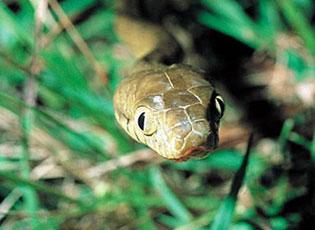Boiga irregularis (Merrem, 1802) (ITIS)
Brown tree snake (BTS)
Australia, Indonesia, Papua New Guinea (Colvin et al. 2005)
First detected in Guam in the 1950s (Colvin et al. 2005)
Likely arrived in Guam accidentally in imported cargo (Colvin et al. 2005)
Preys on native lizards and birds (Colvin et al. 2005); causes frequent power outages by climbing on electrical wires (Colvin et al. 2005)
Guam; not currently established in the continental U.S.

Brown Tree Snake, The "cat eyes" appearance is a distinguishing characteristic.
Gordon Rodda; DOI, United States Geological Survey
Find more images
Spotlights
Federally Regulated
All Resources
Selected Resources
The section below contains highly relevant resources for this species, organized by source.
Council or Task Force
Partnership
Federal Government
State and Local Government
Colvin, B.A., M.W. Fall, L.A. Fitzgerald, and L.L. Loope, 2005. Review of Brown Treesnake Problems and Control Programs: Report of Observations and Recommendations [PDF, 262 KB]. Published at the request of the U.S. Department of Interior, Office of Insular Affairs for the Brown Treesnake Control Committee.
Integrated Taxonomic Information System. Boiga irregularis. [Accessed Mar 24, 2023].
